#Alistair Moffat
Text

An important point on intellectual snobbery, made by Alistair Moffat in his book “The Sea Kingdoms”
#reading#books#Celtic#Celtic languages#Gaelic#Welsh#mabinogion#fenian cycle#tain bo cuailnge#Alistair Moffat#sea kingdoms#intellectual snobbery#history
14 notes
·
View notes
Text
Is Something Missing?

Alistair Moffat took me on a spiritual quest on the Isle of Lindisfarne .
Upon reading, inspiration hit like lightning
What’s been missing on this transitionary quest I’ve been on since changing my life in 2020? Anything? I’m not sure. I’m working on a number of my life goals pretty consistently; let a couple slide, nothing serious. I’ve traveled; I’ve written a helluva lot; spent amazing times with my grandchildren; carefully shepherded my doggie herd and still have many projects left to complete. Wife and I are having a blast seeing so many places and look forward to our futures. What is missing? I received an inkling while reading this morning.
I’m deeply engrossed with Alistair Moffat’s book To The Island of Tides: A Journey to Lindisfarne. The medieval monastery at Lindisfarne was the site of the first recorded Viking attack on Britain in 793. The monks wrote of ominous events that preceded the Viking raid:
Her wæron reðe forebecna cumene ofer Norðhymbra land, ⁊ þæt folc earmlic bregdon, þæt wæron ormete þodenas ⁊ ligrescas, ⁊ fyrenne dracan wæron gesewene on þam lifte fleogende. Þam tacnum sona fyligde mycel hunger, ⁊ litel æfter þam, þæs ilcan geares on .vi. Idus Ianuarii, earmlice hæþenra manna hergunc adilegode Godes cyrican in Lindisfarnaee þurh hreaflac ⁊ mansliht.*
("In this year fierce, foreboding omens came over the land of the Northumbrians, and the wretched people shook; there were excessive whirlwinds, lightning, and fiery dragons were seen flying in the sky. These signs were followed by great famine, and a little after those, that same year on 6th ides of January, the ravaging of wretched heathen men destroyed God's church at Lindisfarne
The Chronicles also presents the frightening prayer : Domine Deus salva nos a furore Northman. (Lord God, save us from the fury of the Northman).
Moffat’s focus on the Viking raid is only done in a cursory manner, as his quest is a spiritual one that reflects the journey of the much admired Saint Cuthbert who was prominent in the founding of several monasteries in the area, Lindisfarne being one. Cuthbert, after a lifetime of being an advocate of the early Celtic church, returned to the Isle in his twilight years to detach himself from the struggles of the world and look inward to better know God. A universal quest that all seek, even Moffat who is an atheist.
Moffat relates the story of Donald MacIver who, in the 1890’s, received a letter from an uncle who lived in Canada who had survived “The Clearances” of the Gaelic peoples of Scotland and Ireland. The British had shipped off his uncle Domhnall Ban Crosd from the Isle of Lewis to Canada as a young man.** It is of little surprise that “Crosd” was added to his name. Crosd means grumpy and Domhnall had good reason to be grumpy. Domhnall facing the end of his years, suffered from homesickness and a deep desire to see the land of his birth one last time. As I read, I discovered the Gaelic word “ionndrain.” The word, roughly translated means, a missing piece perhaps referring to the thought that a part of his soul had been left behind. Upon returning to his village, his heart was broken to see the completeness of the English cruelty. His home village had been razed to the ground and Domhnall Ban crumpled and wept.***
The story, powerfully written, awakened the thought of what might be missing in my current stage of life and would it be too late to retrieve it? The term “missing piece” doesn’t imply anything trivial like a missed appointment or losing one’s wallet. The meaning that I drew was a piece missing spiritually, of something familial or some sort of purpose. All of these possibilities are extremely subjective in nature and their pursuit strictly individual in nature. It’s my feeling that this concept need not take the form of regret, just something that was displaced by time. The whole idea was a bit unsettling as I read and drew me immediately inward. Do I miss my sons? Yes, but I’m proud and happy with they way are pursuing their lives, so I don’t think it’s the missing piece. Spiritual? As I mentioned, it’s a very subjective mindset, and though my spiritual beliefs are very much unconventional in regards to my raising; I believe myself to be the best “me” I’ve ever been in my life. With complete certainty, I believe that often in my life I’ve been a selfish s.o.b. Hopefully that is completely in the past.
Full blown in the “I got more behind me than in front of me” state of consciousness, a completeness of coming full circle is in order. Moffat wrote in admiring tones of the solitary, inward exploration of Saint Cuthbert and other monks of the Medieval age though his self examination is timeless and necessary. I can’t say at this moment that I have this figured out at all; but it is a path I feel compelled to explore …to leave nothing on the table as it were. There is a sense or need to identify any missing pieces, but not in any immediate sense, I ain’t going anywhere anytime soon. This teacher in transition is well aware that the transition will never end; but like the many goals I’ve set for myself, this is part of this amazing time of self discovery.
*Anglo Saxon Chronicles
**Moffat, Alistair; To The Island of Tides: A Journey to Lindisfarne; Canongate Books LTD.; 2019
***IBID. pg. 225
#open mind#retirement#coffetime#stress#change#teacher#i need friends#health#writing#education#Alistair Moffat#lindisfarne
1 note
·
View note
Text
Peasant Magazine is FREE.
Why? Peasants have no money. Because this is the way the world works. Authors have to give away free short stories in order to grab the attention of readers who are admittedly like old cats who don't want to do anything, but once they find something that they like they're suddenly like kittens on catnip.
I know this because I am a reader too, so I understand the feeling of "I don't want to try reading this book because I might not like it." It is like trying a new vegetable. Am I going to like this new vegetable? Or does it taste like rotten cabbage?
But just like vegetables sometimes what you need is a platter to choose from to sample a tiny bite of each to see which ones you do like.
That's basically what literary magazines are. They're full of short stories for people who want to try bite sized pieces (samples really) from different authors to see which ones they like. If they find something that they like then they might go buy a whole vegetable book and read it. Maybe they will read the whole series of books.
Maybe they will even leave reviews on Amazon or Goodreads about how great the books are.
For the author this means that other people will see those 5 star reviews and possibly make a purchase too, which could lead to more reviews and more readers, and hopefully the author makes enough sales that they continue to write without feeling like they are wasting their time.
And it all comes back to the literary magazine.
So why is Peasant Magazine free?
Well, for starters it has no budget and is nonprofit. It is produced by volunteers and the writers involved are all indie authors who see value in getting their short stories in front of an audience who wants to eat read samples from different sources. Because vegetables books are sometimes yucky yummy.
Learn more about Peasant Magazine at
Where you can eat download the free PDF of Issue #1.
Or you can purchase the 8×11 magazine for $4.99 USD (the price was necessary to cover the printing costs) for those people who prefer to read a physical magazine that they can hold.
CONTENTS
"The Pale Lady in White" by Charles Moffat
"The Selkie's Silver Comb" by Alistair Grant
"The Glamouring of Brond Col" by Carl F. Northwood
"The Tone of Truth" by Sean Mooney
"The Choosing" by Len Berry
"The Selkie" by C. M. Neary
"Drifting" by Brigham Magnusson
"The Tale of the Key of Darkness" by Jeffrey J. Hoy
"Beyond Anwar" by D. G. Ironside
"The Hunt" by Liam Porter
"The Last Lesson" by Frankie G.
"With the Death of Kings" by Denise Longrie

#literary magazines#literary journal#fantasy magazines#fantasy journal#fantasy short stories#fantasy short story#historical fiction#historical fantasy#author#writing#fantasy#fantasybooks#fantasy books
8 notes
·
View notes
Text
"LITTLE WOMEN" (1970) Review
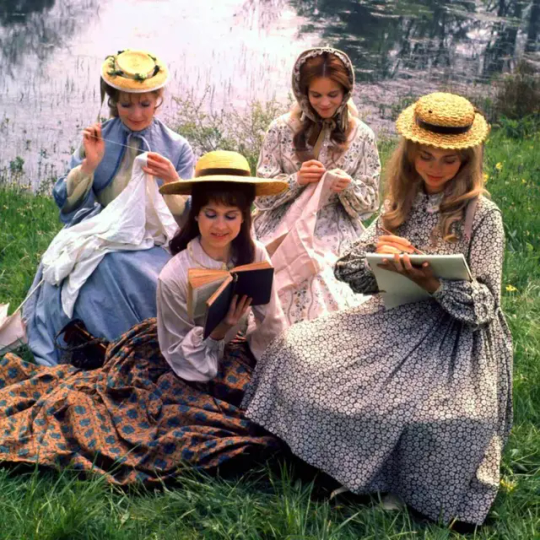
"LITTLE WOMEN" (1970) Review
It is very rare to find a British adaptation of an American novel. It is even rarer to find more than one adaptation. Louisa May Alcott's 1868 novel, "Little Women" must have been very popular with the BBC network. The latter had adapted the novel four times. Several years ago, I had seen the network's 2017 version. I thought it was the only version adapted by the BBC . . . until I had stumbled across the 1970 adaptation.
Set during the 1860s decade, "LITTLE WOMEN" told the story of the four March sisters of Concord, Massachusetts and their coming of age stories during and after the U.S. Civil War. With second daughter Josephine aka Jo serving as the story's main protagonist, the miniseries focused on the sisters' struggles with the family's diminished finances, their personal ambitions and especially their love lives. Early in the story, the March sisters become acquainted with their neighbor, one Theodore "Laurie" Lawrence, grandfather Mr. Lawrence and his tutor, John Brooke. Whereas third sister Beth develops a friendship with the elderly Mr. Lawrence, oldest sister Meg falls in love with Mr. Brooke, and the youngest Amy develops from a slightly vain and coddled child to a mature and self-assured young woman. As for Jo, the story focused on her development from a temperamental and stubborn girl, who learns to maintain her hot temper, navigate through her relationships with two men and adhere to her ambitions to become a writer.
Another surprising aspect of "LITTLE WOMEN" that I had learned was that it was the longest adaptation of Alcott's novel with a total running time of 225 minutes. This gave screenwriters Alistair Bell and Denis Constanduros to be as faithful to Alcott's novel as possible. Were they? Somewhat. The pair did take care to explore Laurie's volatile relationship with his grandfather - something that a good number of the other adaptations had failed to do. And it allowed glimpses into his growing relationship with Amy in Europe. Also, the early stages of Meg's marriage to Mr. Brooke ended up being explored, something that only the 2019 movie adaptation had repeated. I believe the miniseries did a very solid job of conveying these aspects of Alcott's novel.
But the miniseries left out Meg and Laurie's experiences at Annie Moffat's party. The miniseries also left out the sisters meeting with Laurie's English friends - something only the 2017 adaptation had included. Bell and Constanduros had changed the time period of Amy's near drowning at Walden Pond from the winter to either the spring or summer, allowing a rickety pier to send her into the pond, instead of thin ice. And it never touched on Amy's violent encounter with her schoolteacher over pickled limes. Did these aspects of the screenplay harm the production? Hmmmm . . . perhaps not. But I do feel that the miniseries' increased emphasis on the Lawrence men's relationship came dangerously close to overshadowing the March sisters' own relationships. I am relieved that the miniseries managed to focus somewhat on Jo's relationship with Professor Bhaer. However, I do have a problem with the sexist manner in which Constanduros and Bell had the professor viewed his future marriage to Jo. Whatever admiration Professor Bhaer had for Jo's writing skills seemed to fly out of the window in his anticipation of her being a good wife. Superficially, I had no problems with the brief focus on Meg and John's marriage, even if it could have been somewhat more thorough. But I believe it exposed what I believe was one of the miniseries' main problems.
"LITTLE WOMEN" did have its share of problems. Like the 1978 television adaptation, it is clear to see that it suffered somewhat from a low budget. If I must be frank, that seemed to be more obvious in this adaptation. Aside from Amy's near drowning at Walden Pond and some of European settings featuring Amy and Laurie, all other scenes had obviously been shot inside a studio. Very disappointing, considering a good number of BBC productions featured a mixture of interior and exterior shots. I found the actresses' makeup and hair - especially the latter - to be inconsistent and frankly, a big mess. Betty Aldiss' costume designs seemed solid enough, but not particularly earth shattering. Although the cast solely featured British performers, I believe a handful of them managed to handle American accents quite well - especially Stephen Turner, Stephanie Bidmead and Martin Jarvis. But despite their solid or excellent performances, the rest of the cast seemed to struggle maintaining one. And could someone please explain why three of the actresses who portrayed the March sisters seemed to be incredibly loud? Nearly every time one of them spoke, I had to turn down my television's volume. Some have explained these scenes featuring quarreling between the four sisters. They have even gone as far to claim this adaptation was the only one that featured the sisters often quarreling. Well, they would be wrong. Nearly every adaptation (I am not certain about the 1933 movie) of Alcott's novel featured quarrels between the sisters. So, this explanation does not strike me as a good excuse for the loud voices.
Judging from the previous paragraph, one would assume I have a low opinion of the majority of performances featured in "LITTLE WOMEN". Not really. Most of the performances featured in the miniseries struck me as pretty solid. Actresses Angela Down ("Jo"), Jo Rowbottom ("Meg"), Janina Faye (Amy) and Sarah Craze ("Beth") all gave solid performances and managed to capture the nuances of their individual characters in a competent manner. As I had stated earlier, I had a problem with most of them - with the exception of Craze - resorting to loud and histrionic voices in their portrayals of the March sisters at a younger age or in the case of Rowbottom, engaged in a heated quarrel. I thought Jean Anderson gave a solid performance as the stuffy Aunt March. Frederick Jaeger gave a very likeable performance as Jo's love interest, the intellectual Professor Friedrich Bhaer. And I believe the actor had a solid screen chemistry with Down. I really had a problem with actress Pat Nye, who portrayed the family's housekeeper, Hannah. Nye's handling of Hannah's American accent struck me as ridiculously exaggerated . . . to the point that her accent almost seemed Southern. Patrick Troughton, a talented actor in his own right, had more or less been wasted in his role as the family's patriarch, Mr. March. I do not believe he had spoken more than three to five lines in this production.
I can think of at least four performances that really impressed me. It seemed a pity that not one of them came from the four actresses who portrayed the sisters. Oh well. John Welsh has my vote as the second best version of Mr. James Lawrence, the March family's wealthy neighbor. I thought he did an excellent job of developing his character from a strict and curmudgeon guardian to a warm-hearted man who learned to develop a relationship with his grandson. Most portrayals of John Brooke, Meg's future husband, have never impressed me. But I must say that I found Martin Jarvis's portrayal of the character more than impressive. The actor was given an opportunity to delve more into Mr. Brooke's personality and he ended up giving one of the better performances in the miniseries. If given the chance to vote for the best performance in "LITTLE WOMEN", I would give it to Stephen Turner for his portrayal of the sisters' close friend, Theodore "Laurie" Lawrence. I suspect Turner had greatly benefited from Bell and Constanduros's script, which seemed more interested in Laurie as a character than the four leads. But judging from Turner's performance, I suspect his would have overshadowed everyone else's due to the actor's superb handling of the character. I also have to compliment Stephanie Bidmead's portrayal of the March family's matriarch, Mrs. "Marmee" March. Not only did I find her performance warm and elegant, but it also lacked the dripping sentimentality of the earlier versions and the heavy-handed attempts to make the character "modern" - relevant to today's movie and television audiences.
"LITTLE WOMEN" had its flaws. I cannot deny this. But I feel its flaws - which included a limited budget and some questionable American accents - were not enough to dismiss the nine-part miniseries as unworthy. I believe the 1970 miniseries proved to be a lot more solid and entertaining than some fans of Alcott's novel believed, thanks to Paddy Russell's competent direction, a damn good screenplay by Denis Constanduros and Alistair Bell, and a first-rate cast led by Angela Down.
#costume drama#period drama#period dramas#little women#little women 1970#louisa may alcott#little women bbc#jo march#angela down#meg march#jo rowbottom#janina faye#amy march#sarah craze#beth march#stephanie bidmead#stephen turner#martin jarvis#frederick jaeger#patrick troughton#pat nye#u.s. civil war#john welsh#paddy russell#denis constanduros#alistair bell
6 notes
·
View notes
Note
Book Asks: 3 & 6 pls! Tx
Thanks for the Ask, Anon!
3: what is your favourite genre?
Science Fiction and Fantasy; Romance; Murder Mystery/Police Procedural; Historical Fiction; Poetry; Plays; Non-Fiction. My reading tastes are pretty eclectic!
6: what books have you read in the last month?
Blimey, this is a list, given I've already ready nearly 170 books so far this year!
Deadly Wishes (Detective Zoe Finch, #1) - Rachel McLean
Deadly Choices (Detective Zoe Finch, #2) - Rachel McLean
The Stubborn Light of Things: A Nature Diary - Melissa Harrison
Deadly Desires (Detective Zoe Finch, #3) - Rachel McLean
Bedtime Adventure Stories for Grown Ups (memoir) - Anna McNuff
Constable on the Hill (Constable Nick Mystery, #1) - Nicholas Rhea
How to Paddle a Kayak: The 90 Minute Guide to Master Kayaking and Learn to Paddle Like a Pro - Scott Parsons
Outrage on Gallows Hill (Thomas Littlejohn #13) - George Bellairs
Dreaming of Flight - Catherine Ryan Hyde
Doctor Who: The Eaters of Light - Rona Munro
Deadly Terror (Detective Zoe Finch, #4) - Rachel McLean
The Hidden Ways: Scotland's Forgotten Roads - Alistair Moffat
Deadly Reprisal (Detective Zoe Finch #5) - Rachel McLean
Persuasion - Jane Austen
Back in the Frame (memoir) - Jools Walker
The Worry Tiger - Alexandra Page (illus Stef Murphy
Deadly Fallout (Detective Zoe Finch #6) - Rachel McLean
Consolation Songs: Optimistic Speculative Fiction For A Time of Pandemic edited Iona Datt Sharma
I'm currently reading Quiet: The Power of Introverts in a World That Can't Stop Talking - Susan Cain
[Ask me about Books]
1 note
·
View note
Text
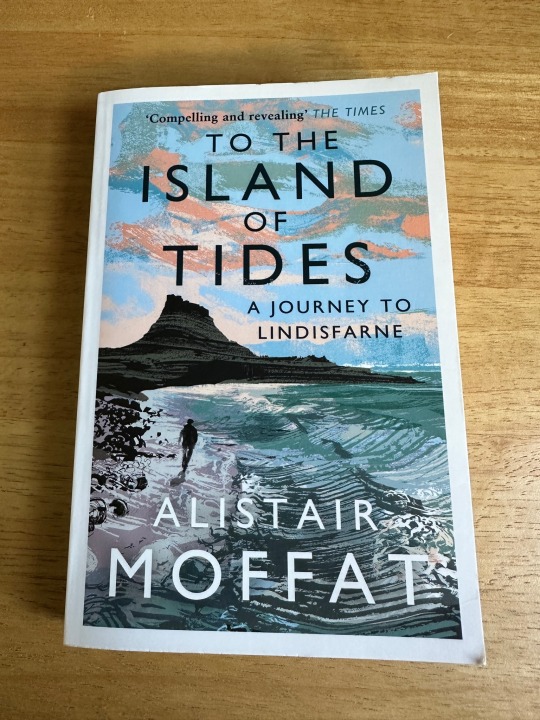
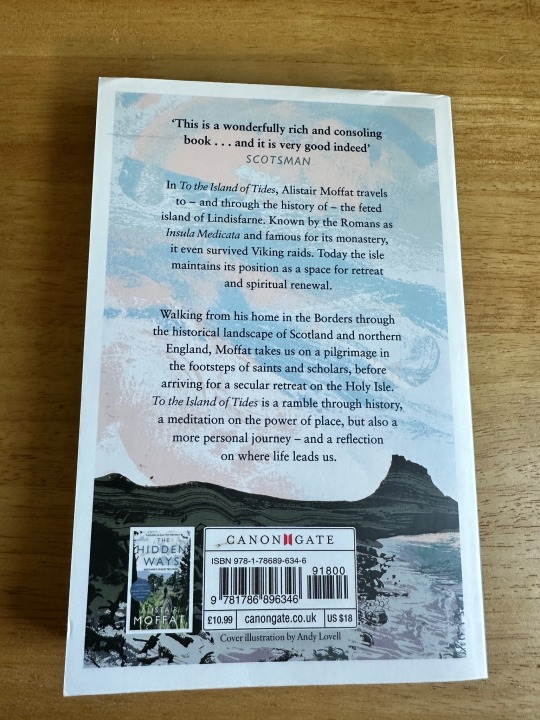
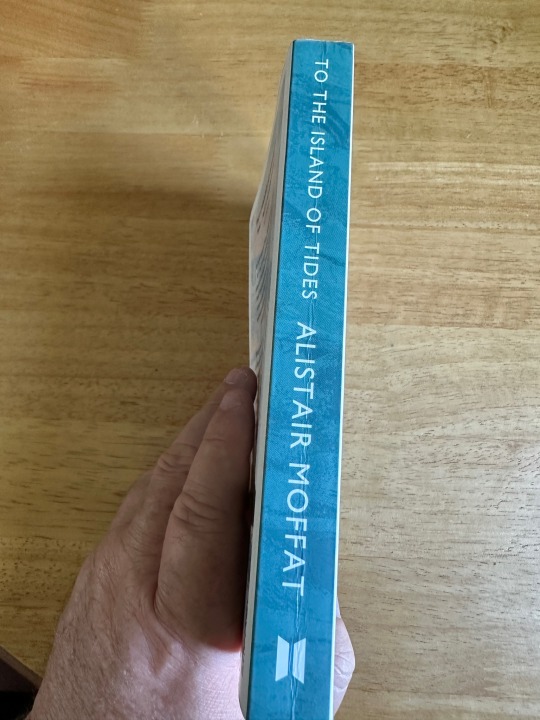



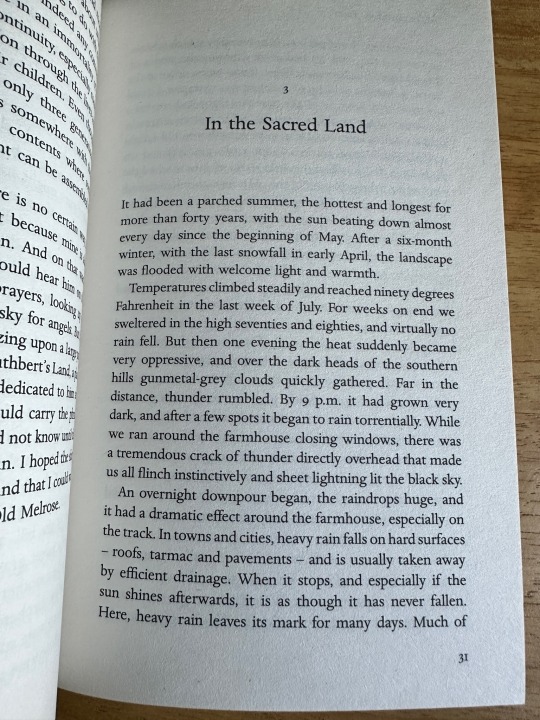


0 notes
Text
Place-names can be emblematic, compressed nuggets of forgotten history, and the mouth-filling sensuousness of Lindisfarne may have a tale to tell. It seems that the Romans knew it as Insula Medicata, and that may have referred to an island where plants grew that were useful for making balms, poultices or decoctions. Dialects of Old Welsh were spoken down the length of Britain before and after the Roman province of Britannia, and the native name of Ynys Medcaut derived directly from the Latin name.
Alistair Moffat, To the Island of Tides: A Journey to Lindisfarne
28 notes
·
View notes
Text
Book Review 18 - The Sea Kingdoms
16/20
The Sea Kingdoms by Alistair Moffat is a non fiction history book about the history of Celtic Britain and Ireland and the remnants that still exist today. This is an account of the people, culture, stories and battles that moulded the ancient British Isles.
This was a really great, concise and brief account of ancient Britain and Ireland. Moffat has written an informative and entertaining history of the ancient Celts and could serve as a great introduction for those interested in learning more about these people and this time period.
2 notes
·
View notes
Note
Super controversial opinion, but I like how Moffat handled the Brig. He establishes that the Doctor genuinely respects the Brig, and still mourns his passing. (Mind you, this is also a plot where Missy brings back literally all the Dead people on Earth as Cybermen-which is a very Master thing to do. And the Brig was established to be dead in Eleven's run. Unsurprisingly, Missy ends up taking a Cyberman energy blast, and the Doctor is able to, after so long, return the salute to his dear friend.)
(I can see why it would piss people off, but I think it's a good end for the Brig. At the end of the world, he'd be right in the thick of it, fighting alongside the Doctor. (And if anyone could fight off Cybermen reprogramming, of course it would be Brigadier Allistair Gordon Lethbridge Stewart. Dude's got one of the strongest wills of any of the Doctor's Companions.))
(Again, I know it's a very controversial opinion, and I think I remember you being angry about it at one point-which is honestly fair, and I can see why. But I like it. The Brigadier is a protector of the world and a friend of the Doctor, and not even the Master's post-mortem Cyberconversion can ever strip that from him. He is Sir Alistair Gordon Lethbridge-Stewart, and he will not give in or bow to the Master's attempts to control him. (I know my opinion is garbage, but I still like it.)
I agree that Moffat is kind of a prick: the last two seasons of Sherlock, and their outright mocking of the fans in the show itself, proved that for me. But his era of Doctor Who is still my favorite. (You know how people get mad when theh see people diss their favorite showrunner? I get apoplectic seeing hate on Moffat's era, even though I know they're right. But I just really like his era of Doctor Who. I love the themes and the characters and the storylines and the Monsters. It's... Good.)
(I know my opinion on Moffat's era is objectively bad: dude is a poor writer under a lot of circumstances, and I HATE how he handled Sherlock: season 4. But as far as Doctor Who showrunners go, he's far from the worst.)
(Sorry I just went off about Doctor Who like that. It was 4:30 AM and I was exhausted. I wasn't trying to be rude about any of it, and I'm sorry if I was. (Minor point of correction is that I get annoyed when I see Moffat hate, not apoplectic. Not sure why I wrote that.) I do like Eleven and Twelve's eras the most, but I still love RTD's era. (Haven't really gotten into Thirteen, but that's because of a difficulty finding a place to watch the episodes, not out of anything else. Thirteen's cool.)
It's all good, friend! :D Everyone is going to have a different opinion on how each show runner handles things. Not everyone will resonate with the decisions made. It so happened that I didn't enjoy what Moffat did with Eleven, and so opted not to keep watching with Twelve. Others enjoyed it plenty, and that's fine too!
I mean, I can't talk about quality. I enjoyed The King's Demons XD
But yeah, it's all good :)
3 notes
·
View notes
Text
Memory Loss Chapter 7 Preview
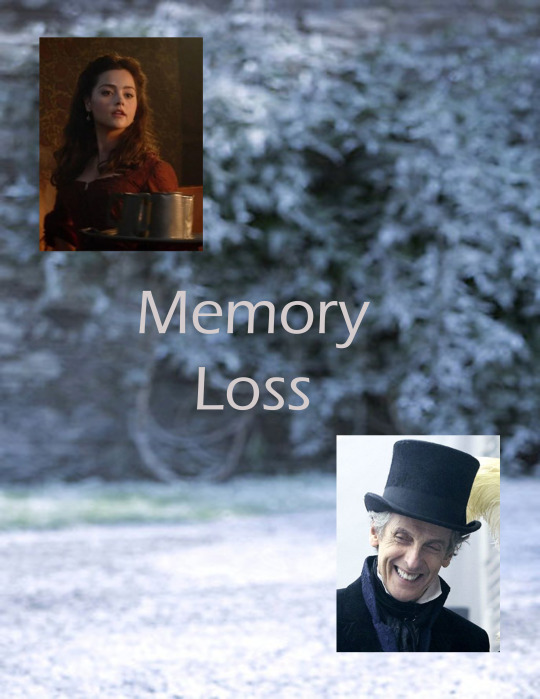
“We found another witness.”
Mr Moffat’s face lit up at the mention of this.
The detective cleared his throat. “The witness saw two men on horses carrying what he thought looked like cargo at first until he saw a hand slip from underneath the cover,” he revealed.
“What?!” Missy exclaimed in shock. “Please tell me you’ve found him!” Alistair shook his head. “The witness saw the men leaving London, heading south.”
“What are you waiting for then?” Missy demanded. “You should be out there looking for him!”
#whouffaldi#12 x clara#12 and clara#twelve x clara#twelve/clara#twelve and clara#the doctor#clara oswald#the impossible girl#12#12th doctor#twelfth doctor#doctor who#fanfiction#memory loss
6 notes
·
View notes
Note
Hi! I hope you're well - I was just wondering if you had any recommendations for interesting & engaging "introductory" texts about Scottish history (particularly between 500 and 1500 AD, although I know that's really broad!) No worries if you don't have any ideas or don't feel like answering such a vague question though! Have a lovely day :)
Hi!
Apologies for the delayed response on this, I have no real excuse except being anxious that I wouldn’t be able to answer it perfectly. So I’ve decided to bite the bullet and answer somewhat imperfectly. This answer also depends on just exactly how much knowledge you already have of Scottish history, so if I’m being patronising and assuming too much ignorance, or alternatively if I’m not being clear enough, please let me know.
The first thing I would always recommend before diving into serious literature is having a basic framework in the back of your mind. It may be an inaccurate framework but given that mediaeval Scottish history really isn’t taught or known to the same extent as say mediaeval English history, it is essential that you know where you are on a basic level, so you can both enjoy and learn from the texts that go into more detail. This basic background can come from almost anything- Braveheart and blatantly inaccurate novels aside.
This is quite freeing because basically reading almost ANYTHING can be useful at first, and also first and foremost if you’re going to devote a considerable amount of time to something, you should work out how to make it fun and understandable.
I always had some idea of Scottish history since I was a kid but I got more into it in my late teens and I’ll be honest, though I probably don’t agree with anything in it pages now, one of the first books I picked up at the age of about sixteen was Neil Oliver’s ‘History of Scotland’ (released alongside the documentary series). Any basic ‘History of Scotland’ of that type (if it looks reasonably reputable) should give you a basic framework that you can build on- in the same way some people learn the kings and queens of England. Wikipedia could also work this way, though it may be more patchy. Other, slightly more reputable and in-depth but not really textbook, works of this kind include Stewart Ross’ “The Stewart Dynasty”; Alistair Moffat’s ‘The Borders’; popular (if coloured) biographies of people like Robert the Bruce, William Wallace, and Mary Queen of Scots (she’s post-medieval but still a relevant example); and even some of the older Victorian histories of people like Tytler (watch out though, they get weirdly ‘ethnic’ in their interpretations of some historical events and processes- some were convinced that there was a centuries-long feud between the “Celt” and the “Teuton”/”Saxon”). Even novels and songs- though sometimes highly inaccurate- can help with this, even if they’re Walter Scott.
So I’m not going to be a purist and get snobby about Neil Oliver or Walter Scott even if I would never set store by any of the above works in an academic context (or even just a drunken argument). The first step in my view is literally to get a basic feel for what we *think* our history is (and enjoy learning about the different regions and cultures a bit!), and then you can set about dismantling all these stereotypes and misconceptions with better books.
If you DO want a reasonably trustworthy general overview though, I believe that Fiona Watson has written one called “Scotland: From Prehistory to Present” and there must be a few others written by academics, it’s just been so long since I’ve read completely general histories I can’t really comment on this accurately.
Assuming you’re already aware of the above though and have a pretty good idea of what you’re dealing with then there are two next steps I would recommend.
The first are the series of texbooks/overviews that are often published by universities. Obviously since these are textbooks they are more introductory and general, but they do often cite academic articles and books that are more detailed. I have found a couple of series particularly useful and outlined the main titles below:
- The “New History of Scotland” series. This is a good series as most of the books were initially A5 sized or slightly bigger (so quick to read and easy to carry). Sadly this means that they do not employ footnotes/citations to any great extent, usually only providing a ‘Further Reading’ section at the end of the book. You can usually find old copies of these online for a reasonable price. This series includes, among others:
- “Warlords and Holy Men: Scotland, 80-1000”, by Alfred P Smyth
- “Kingship and Unity: Scotland, 1000-1306″, by G.W.S. Barrow
- “Independence and Nationhood: Scotland, 1306-1469″, by Alexander Grant. (This one has a particularly good basic overview of diet, trade, e.t.c.)
- “Court, Kirk, and Community: Scotland, 1470-1625″, by Jenny Wormald
- “Power and Propaganda: Scotland, 1306-1488″, by Katie Stevenson (note- the previous titles listed were written in the 1980s and 90s, but this one was added to the series in 2014, so it’s more up to date in some ways though it’s up to you whether you think it’s more persuasive).
- The “New Edinburgh History of Scotland” series. These are bigger books than the previous series and are complete with on page citations and bibliography. They tend to all come in matching blue jackets, and I thought that secondhand copies of these would be slightly more expensive than the above but a quick search on amazon has surprised me, since a copy of Oram’s “Domination and Lordship” is several pounds cheaper than Grant’s “Independence and Nationhood”. Anyway these are slightly more in-depth than the above series, but work very well in tandem with those shorter books. The series includes:
- “From Pictland to Alba: 789-1070″, by Alex Woolf (it is a very long time since I read this, so I have to admit I have very little memory of its contents but I put it here for balance)
- “Domination and Lordship: Scotland, 1070-1230″, by Richard Oram (good used along with Kingship and Unity)
- “The Wars of Scotland, 1214-1371″, by Michael Brown
- “The First Stewart Dynasty In Scotland, 1371-1488″, by Stephen Boardman (full disclosure I have not read this one yet, but I have read some of Boardman’s other books).
- “Scotland Reformed, 1488-1587″, by Jane E.A. Dawson
- The “History of Everyday Life” series. These books are collections of essays on some selected aspects of day to day life in medieval Scotland and can provide some interesting reading and insights. Only one of the books in this series is relevant to our time period, but it may be worth checking out the other three since some customs and behavioural patterns from more recent times are worth comparing with the past. The volume covering the medieval period is “A History of Everyday Life in Medieval Scotland, 1000-1600″, edited by Edward Cowan and Lizanne Henderson.
- The “Northern World” series. This is not a series I’m particularly familiar with outside of some light reading while at university (mostly because these books can be really expensive compared to the previous ones mentioned). HOWEVER not only do they range across northern Europe (not just Scotland) but a couple of them help to balance out the Lowland focus which sometimes predominates in the above general overviews. There are quite a few interesting books in this series (identifiable usually by their purple jackets) but some that I know of include:
- “Kinship and Clientage: Highland Clanship, 1451-1609″ by Alison Cathcart.
- “The Lordship of the Isles”, edited by Richard Oram (this is a collection of essays)
There was also an older “Edinburgh History of Scotland” series published in the 1970s- some of the authors were better than others and they’re a bit dated now but they’re still a useful starting point. The series includes:
- “Scotland, the Making of the Kingdom”, by A.A.M. Duncan
- “Scotland: The Later Middle Ages”, by Ranald Nicholson
There are lots of other book series out there- the St Andrews Studies in Scottish History or the publications of old literature by the Scottish Text Society for example but I think I’ve listed enough to be getting on with. There are also a few books that I think make good general overviews (or are collections of interesting essays) that aren’t in a particular series:
- “Women in Scotland, 1100-1750”, edited by Elizabeth Ewan and Maureen M Meikle (this is a collection of essays rather than an overview of women’s history but it’s a good starter, and great if you only have fifteen minutes to spare)
- “Glory and Honour: The Renaissance in Scotland”, by Andrea Thomas (a beautiful coffee table book with lots of pictures of art and architecture). It starts in 1424.
- “The Kingdom of the Isles: Scotland’s Western Seaboard, c.1100-c.1336″, by R. Andrew MacDonald
- “The Black Douglases”, Michael Brown
- “Robert the Bruce’s Rivals: The Comyns, 1212-1314″, by Alan Young
- “The Northern Earldoms: Orkney and Caithness, 870-1470″, by Barbara E. Crawford
- “Scottish Independence and the Idea of Britain: From the Picts to Alexander III”, by Dauvit Broun
- “Virgins and Viragos: A History of Women in Scotland From 1080 to 1980″, by Rosalind K Marshall (Marshall has also written some good introductory overviews on Scottish queens, on Mary of Guise, and on the women around Mary, Queen of Scots, though these last two are sixteenth century).
- Any of Alexander Fenton’s books on agricultural history- they don’t deal exclusively (or even mainly) with the medieval period, and they’re not the most up to date but they are still useful handbooks.
There are also lots of shorter academic articles on JSTOR and elsewhere, as well as online networks for things like Scottish Women’s History and Environmental History.
The second step I would recommend is using biographies- biography is not always the most useful form of historical writing, but they do have their own benefits. For this time period most of the full book-length biographies of individuals are royal figures (though lots of other people are covered in academic articles).
For some figures it’s wise to have several biographies on hand since they’re well-known or controversial- for example, for Robert Bruce, you could start with an older bio like G.W.S. Barrows “Robert Bruce and the Community of the Realm of Scotland” and then supplement it with a more modern biography like that written by Michael Penman or by Colm McNamee. In other cases, a historical figure may not be quite so well known so jumping straight into an academic biography of them, which hops around and analyses expenditure and parliaments, may be a bit confusing- for example, for King James IV, it may be useful to start with R.L. Mackie’s (admittedly dated and a bit romantic) biography to get an idea of the structure of the king’s reign before diving into Norman MacDougall’s more scholarly biography.
Other biographies/overview of royal reigns include Richard Oram’s works on David I and Alexander II; D.D.R. Owen’s bio of William the Lion (this is an interesting one, since it’s written by a French professor rather than a straightforward historian so there’s a big focus on the importance of literature); Andrew Fisher’s bio of William Wallace; Stephen Boardman’s survey of the reigns of Robert II and Robert III; the two biographies of James I written by E.W.M. Balfour-Melville and Michael Brown; Christine McGladdery’s ‘James II’ and Norman McDougall’s ‘James III’; and Annie Dunlop’s biography of Bishop Kennedy.
Lastly once you feel you’ve got a bit of a grip on some secondary source material (or really, as soon as you like) I do recommend checking out some of the primary source material as soon as possible. A LOT of primary sources of medieval Scottish history were printed during the Victorian and Edwardian periods and now thanks to digitisation projects many of them are available online- from chronicles like those of Melrose, John of Fordun and Andrew Wyntoun (and useful English chronicles like Lanercost and Scalachronica); to acts of parliament and accounts of royal expenditure (Treasurer’s Accounts; Exchequer Rolls); to letters of the nobility and poetry. Personally, I find that you learn as much from working directly with the words of historical figures themselves, even if you’re untrained in source handling, as you would from a whole host of textbooks (also it lets you get used to the languages- Scots is straightforward enough to pick up even if you don’t have Latin or Gaelic). If you ever have trouble finding these let me know and I might be able to point you in the right direction.
It is also worth bearing in mind that sixteenth century sources may shed a lot of light on earlier periods.
Anyway hopefully this helped but if you have any other questions please let me know and I will endeavour to reply quicker this time!
*One last disclaimer, the above list of texts is based purely on my own experiences and what my brain could remember quickly- it is not to reflect a bias or to promote these texts above the works of other historians. It is also not an exhaustive or comprehensive list (and some dearly beloved books are not included- but I tried to stick to simple overviews/textbooks and a few other interesting surveys).
And people are very welcome to add to this since there’s lots I’ve missed!
Lastly try to have a bit of fun with it. Some of these books are very informative but can drag at times- on those occasions I highly recommend taking a break and trying to get outside to a hill or a castle, or if you can’t do that try putting an old ballad on on youtube, and physically look at or listen to the thing you’re studying.
#Scottish history#British history#sources#books#reading#Yes now everyone can come and laugh at 16 year old me who got her childhood love of history back from flipping Neil Oliver#And the Corries though they're more respectable if less accurate
22 notes
·
View notes
Text

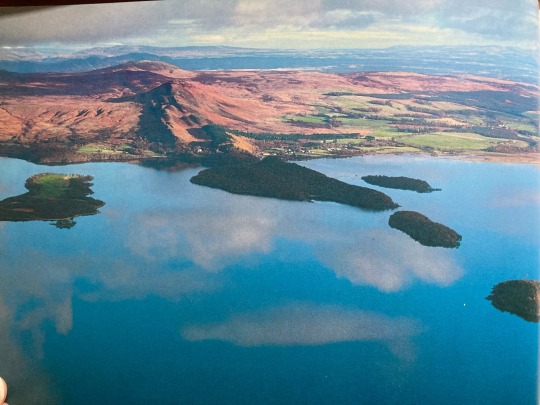
Extract from “Scotland’s Last Frontier” by Alistair Moffat referring to the photograph taken by Patricia Macdonald in “The Highlands and Islands of Scotland”
#scottish highlands#alistair Moffat#Patricia Macdonald#highland line#scottish geology#Scottish geography#loch lomond
3 notes
·
View notes
Text
I No Longer Rage at Fate
(Paraphrasing the great Alistair Moffat)

As My (mine alone) grasp of this reality becomes some kind of “wisdom,” I see no point.
It’s only life …
Transitioning, Transitioning, Transitioning …I was a teacher; or like a Marine, I will always be a teacher; but what hath this transition wrought three years into this journey? Fate? Destiny? Pre-ordination? Nope! I’ll pass, not happily; but wiser I think. You see I’m recreating my universe. Literally? Well, maybe, if you see and understand your world differently then it’s a new reality for you …right? To paraphrase the Apostle Paul, “when I was a child, I thought as a child, spoke as a child and acted as a child; but when I became a man (retiree) I put away childish things.” Seeing yourself free from the daily constraints of the American work model which forces these constraints of time, dogma and goals on us as it serves the purpose of said system, your mind can open. If you let it.
I’ve been writing a lot of poetry to explain the world according to Brent with a little success; but it’s my world view …mine alone. Nothing in life turned out the way I dreamed way back 1989. Nothing. That’s been a good and bad result; I was kind of an idiot in ‘89. It hasn’t been a total path of pain or anything like that, but there has been pain …and loss. Derp! Isn’t that what Buddha told us? There have been spectacular moments of joy as well, stuff I didn’t expect …at …all. The end result being you plan and work and save and devote time to your family and do the right things old books told you to do and it all ends up a crapshoot. Of course there were acolytes that told me, “it all turned out according to plan just not your plan.” So, there was a preordained destiny, plan laid out for me that I knew nothing about? No, no …I’ll just let that nugget of wisdom go …too cold in its application for me.
In my mind agog with time to contemplate why what is and isn’t, I concluded that it is unknowable and just …is? I guess? Examining numerous books that presented various alternative ways of interpreting realities (Celtic, Indigenous, Eastern, “disavowed” Western spiritual concepts, Pope Francis); I came to a remarkable awareness: there is an eternal and we …be …it! So many less commercial faiths saw this unity in nature clearly. Throw in a little developed philosophy and you realize that every physical thing that has ever existed still exists in us. I taste water that may have been tasted by DaVinci, I breathe air that may have refreshed Elizabeth I, I walk ground that countless others have walked. If this is undeniable, consider this: an organ transplant recipient often adopts behaviors of the organ donor, thus our very being is made up of countless previous beings to make us. Is it logical to assume that these beings influence us in some way? To use a popular saying that I detest …I’m just sayin!
“We come not from small things,”* is a sentiment that Alistair Moffat expressed in a series of books he’s written. The statement doesn’t stand alone, but with astute observation of life on his little Scottish farmstead. He sees all the lives and struggles of a myriad of people who walked the spot that he currently identifies as his property; but with humility acknowledges it’s just at this moment. Moffat observes through amateur archaeology and study of maps that show how hubris resulted in humans attempting to mold the land to suit their will. Silly, silly rabbits. It lasts but for the moment and the agents of change do their thing. We are the agents. Taking conscious and unconscious cues from antiquity and more recent generations. We are all in flux, it’s all new, it’s nothing new. Billions of stars and billions of people are in us lighting our way and as we embellish our realities and say, “look what I did!”
How has this “enlightened “ me? A lot of ways I suppose, I ask why a whole lot less. Time is a man made construct and I find, with varying degrees of success, that I feel more at ease with ancient rhythms than the countdown of days, weeks, months and years. I’m free, again with varying degrees of success, from the need to rage at fate. Things happen for incalculable reasons from infinite influences …how can I hope to understand them all. The reality according to Brent is a truth for as long as I last, then I will be a part of a new existence. The reality according to Brent will become the reality according to who? It’s ok, we’ve done this before.
*Moffat, Alistair; The Secret History of Here; Canongate Books LTD.; 2021
0 notes
Text
tagged by @medlit-study thank you!! 💕
Last song: The Birthday Suit - Love isn’t Love (I’m a bit obsessed with them at the moment)
Last film: uhm, I think that must’ve been Werk ohne Autor (Never Look Away) some time before NYE. iirc that movie felt like it was 100 hours long (but a lot of movies do tbh) and I still liked it quite a lot
Currently reading: A Darker Domain by Val McDermid, but I’m also very excited to start Alistair Moffat’s In Search of Angels soon because I got it for Christmas and it sounds as if it will tick all my boxes. (mostly I’m just happy that I've finally finished the Shetland novels so I can move on to better things shhhhh)
Currently watching: I started watching this Norwegian TV series Twin a while ago, but have had neither the time nor the energy to continue (my days feel rather full at the moment thanks to uni & homeschooling so in the evenings I’m dead tired and just relax with meditation & reading & listening to podcasts etc)
Craving: strawberries! I’m using this jigsaw puzzle app and it has become part of my nighttime routine (perfect activity to do whilst listening to audio plays) and yesterday there was this picture of a strawberry cake that just looked absolutely delicious and it’s been months since I last had some so now I can’t stop thinking about strawberries lmao 🍓
I’m tagging @a-chorus-of-storytellers @greenapricot @bryndeavour @vita-s-west @onlypassingthroughh @thetimemoves
6 notes
·
View notes
Text
Thank you for the tag @cloudsofcorduroy 💙
Currently listening to: The frozen 2 soundtrack (been put online for a few weeks and needed an instant dopamine hit....)
Last movie I watched: Rush (it was actually frozen 2 but given my answer for the last question I’ve done the last non Disney film lol)
Currently watching: White Collar (and rewatching suits season 2)
Currently reading: (Asides from my assignment lol) The Scots: a genetic journey by Alistair Moffat.
Currently craving: A city break (I’m a travel junkie) and Italian food. So I’m going to combine that to mean a weekend in an Italian city 😆
Idk who to tag but I enjoyed doing this haha! If anyone does follow me and wants to do it feel free :) still pretty new to this site 💙
2 notes
·
View notes
Text
To the Island of Tides - Alistair Moffat
To the Island of Tides – Alistair Moffat
Non-fiction.
A pilgrimage, by its nature, is a personal journey of discovery as well as a geographical and historical trek. In To the Island of Tides, Alistair Moffat follows in the footsteps of Saint Cuthbert (634 – 687); monk, bishop and hermit. From the Scottish Borders to the Holy Island of Lindisfarne, Moffat endures a broken rib and faces some deep familial sadness as he immerses himself in…
View On WordPress
0 notes